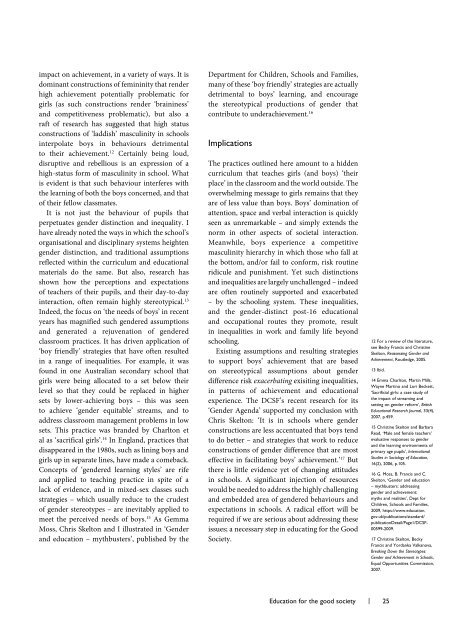impact on achievement, in a variety of ways. It isdominant constructions of femininity that renderhigh achievement potentially problematic forgirls (as such constructions render ‘braininess’and competitiveness problematic), but also araft of research has suggested that high statusconstructions of ‘laddish’ masculinity in schoolsinterpolate boys in behaviours detrimentalto their achievement. 12 Certainly being loud,disruptive and rebellious is an expression of ahigh-status form of masculinity in school. Whatis evident is that such behaviour interferes withthe learning of both the boys concerned, and thatof their fellow classmates.It is not just the behaviour of pupils thatperpetuates gender distinction and inequality. Ihave already noted the ways in which the school’sorganisational and disciplinary systems heightengender distinction, and traditional assumptionsreflected within the curriculum and educationalmaterials do the same. But also, research hasshown how the perceptions and expectationsof teachers of their pupils, and their day-to-dayinteraction, often remain highly stereotypical. 13Indeed, the focus on ‘the needs of boys’ in recentyears has magnified such gendered assumptionsand generated a rejuvenation of genderedclassroom practices. It has driven application of‘boy friendly’ strategies that have often resultedin a range of inequalities. For example, it wasfound in one Australian secondary school thatgirls were being allocated to a set below theirlevel so that they could be replaced in highersets by lower-achieving boys – this was seento achieve ‘gender equitable’ streams, and toaddress classroom management problems in lowsets. This practice was branded by Charlton etal as ‘sacrifical girls’. 14 In England, practices thatdisappeared in the 1980s, such as lining boys andgirls up in separate lines, have made a comeback.Concepts of ‘gendered learning styles’ are rifeand applied to teaching practice in spite of alack of evidence, and in mixed-sex classes suchstrategies – which usually reduce to the crudestof gender stereotypes – are inevitably applied tomeet the perceived needs of boys. 15 As GemmaMoss, Chris Skelton and I illustrated in ‘Genderand education – mythbusters’, published by theDepartment for Children, Schools and Families,many of these ‘boy friendly’ strategies are actuallydetrimental to boys’ learning, and encouragethe stereotypical productions of gender thatcontribute to underachievement. 16ImplicationsThe practices outlined here amount to a hiddencurriculum that teaches girls (and boys) ‘theirplace’ in the classroom and the world outside. Theoverwhelming message to girls remains that theyare of less value than boys. Boys’ domination ofattention, space and verbal interaction is quicklyseen as unremarkable – and simply extends thenorm in other aspects of societal interaction.Meanwhile, boys experience a competitivemasculinity hierarchy in which those who fall atthe bottom, and/or fail to conform, risk routineridicule and punishment. Yet such distinctionsand inequalities are largely unchallenged – indeedare often routinely supported and exacerbated– by the schooling system. These inequalities,and the gender-distinct post-16 educationaland occupational routes they promote, resultin inequalities in work and family life beyondschooling.Existing assumptions and resulting strategiesto support boys’ achievement that are basedon stereotypical assumptions about genderdifference risk exacerbating exisiting inequalities,in patterns of achievement and educationalexperience. The DCSF’s recent research for its‘Gender Agenda’ supported my conclusion withChris Skelton: ‘It is in schools where genderconstructions are less accentuated that boys tendto do better – and strategies that work to reduceconstructions of gender difference that are mosteffective in facilitating boys’ achievement.’ 17 Butthere is little evidence yet of changing attitudesin schools. A significant injection of resourceswould be needed to address the highly challengingand embedded area of gendered behaviours andexpectations in schools. A radical effort will berequired if we are serious about addressing theseissues; a necessary step in educating for the GoodSociety.12 For a review of the literature,see Becky Francis and ChristineSkelton, Reassessing Gender andAchievement, Routledge, 2005.13 Ibid.14 Emma Charlton, Martin Mills,Wayne Martino and Lori Beckett,‘Sacrificial girls: a case study ofthe impact of streaming andsetting on gender reform’, BritishEducational Research Journal, 33(4),2007, p.459.15 Christine Skelton and BarbaraRead, ‘Male and female teachers’evaluative responses to genderand the learning environments ofprimary age pupils’, InternationalStudies in Sociology of Education,16(2), 2006, p.105.16 G. Moss, B. Francis and C.Skelton, ‘Gender and education– mythbusters: addressinggender and achievement:myths and realities’, Dept forChildren, Schools and Families,2009, https://www.education.gov.uk/publications/standard/publicationDetail/Page1/DCSF-00599-2009.17 Christine Skelton, BeckyFrancis and Yordanka Valkanova,Breaking Down the Stereotypes:Gender and Achievement in Schools,Equal Opportunities Commission,2007.Education for the good society | 25
1 See www.education.gov.uk/b0065507/gttl/health-safetywelfare/wellbeing.2 See http://education.gov.uk/publications/standard/publication-Detail/Page1/DCSF-WBL-01-08.3 UNICEF, Child Poverty inPerspective: An Overview of ChildWell-being in Rich Countries,Innocenti Report Card 7, UNICEFInnocenti Research Centre, 2007.4 CPAG, Child Wellbeing andChild Poverty: Where the UKStands in the European Table,Child Poverty Action Group,2009.5 See www.oecd.org/pages/0,3417,en_32252351_32235731_1_1_1_1_1,00.html.6 The United Nations Conventionon the Rights of the Child alreadygoes some way towards this.Article 27 recognises ‘the right ofevery child to a standard of livingadequate for the child’s physical,mental, spiritual, moral and socialdevelopment’. In addition, Article29 states that ‘the education ofthe child shall be directed to…the development of the child’spersonality, talents and mental andphysical abilities to their fullestpotential’.5. Well-beingand educationCharles Seaford, Laura Stolland Sorcha MahonyLast November, the Prime Minister announcedthat the nation’s well-being was the ultimatetest of policy. Afterwards, a number of officialspondered with us whether this would lead toa real change in the emphasis of policy, orwhether it was just another ministerial speech.In this article, we ask what the implicationswould be for educational practice, policy andaccountability if policy really were to becomewell-being focused.Delivery not aspirationAt first sight the implications for educationpolicy and practice are less radical than theyare for economic policy. The present and futurewell-being of pupils is better established as anobjective for education than are comparableobjectives for the economy, and GDP growthdominates economic policy in a way that is notthe case for education policy (despite the bestefforts of Lord Browne). The Education andInspections Act 2006 places an explicit duty onschools to promote well-being, 1 understood inline with the Children Act 2004. The Every ChildMatters initiative emphasised physical, mental,emotional, social and economic well-being, aswell as protection, enjoyment and achievement.According to the DfE, concern for the well-beingof children in the UK is ‘reflected in Governmentpolicy, which is placing increasing emphasis notjust on educational achievement, but also on thewider well-being of the child, both in and out ofschool’. 2 Of course, many teachers have alwaysseen their role as helping their pupils to flourish,and this sentiment lies at the heart of seriousattempts to use well-being and its measurementto guide policy.But of course aspiration and reality are wideapart. A UNICEF study showed that the UKscored 21st out of 21 developed countries forchildren’s well-being. 3 In particular, it showedthat the UK scored 17th for educational wellbeing,a domain covering objective measures ofeducational achievement and participation. Astudy by the Child Poverty Action Group andresearchers at the University of York also foundthat young people in the UK scored low forwell-being: they ranked 24th out of 29 Europeancountries for overall well-being, and 22nd outof 27 countries for educational well-being –also understood and measured objectively forattainment and participation. 4 The OECD’sProgramme for International Student Assessmenthas shown that educational attainment rankingsof UK pupils in the core areas of reading, mathsand science have been falling for the last decade. 5At the same time, activities outside the corecurriculum such as music and sport, which helpdevelop the skills needed for flourishing as achild an adult, are all too often marginalised.And the UNICEF study showed that youngpeople’s educational well-being, understood andmeasured subjectively, is also a cause for concern:the UK ranked 15th out of 21 OECD countries onmeasures of young people’s feelings about, andexperiences of, school.This cannot be attributed only to the educationsystem of course. Many other factors, from familylife to access to green spaces, influence whether achild flourishes and will grow into an adult whoflourishes.In short, what matters is not the aspirationbut the delivery, and not simply delivery in theeducation system but delivery across a range ofpolicy areas that impact on children. If makingwell-being the ultimate test of policy ends upmaking a difference, it will be because it hasstimulated new political pressures. These inturn will have led to policies and accountabilitystructures that deliver aspirations more effectivelyand universally than they do now. The trade-offswill be different, and the objective of ‘flourishingchildren’ will do better than it does now in thecompetition of priorities. We might even be ableto turn the aspiration that every child shouldflourish into a right. 6What it means to flourishThis all depends on a shared understandingof what it means to flourish, and what26 | www.compassonline.org.uk
- Page 1 and 2: Educationfor theGoodSocietyThe valu
- Page 3 and 4: Acknowledgements:Compass would like
- Page 5 and 6: ContributorsLisa Nandy is Labour MP
- Page 7 and 8: IntroductionEducation for the Good
- Page 9 and 10: 1 This article has been developedou
- Page 11 and 12: 8 See Ann Hodgson, Ken Spoursand Ma
- Page 13 and 14: 13 The most comprehensiverecent res
- Page 15 and 16: 1 See for example B. Simon, ‘Cane
- Page 17 and 18: 10 J. Martin, Making Socialists: Ma
- Page 19 and 20: the poorest homes (as measured by e
- Page 21 and 22: 1 In 2008, 15 per cent ofacademies
- Page 23 and 24: 1 Angela McRobbie, The Aftermathof
- Page 25: 8 Christine Skelton, Schooling theB
- Page 29 and 30: 13 Barbara Fredrickson, ‘Therole
- Page 31 and 32: 6. Education forsustainabilityTeres
- Page 33 and 34: well as cognitively. Real understan
- Page 35 and 36: 7. Schools fordemocracyMichael Fiel
- Page 37 and 38: and joyful relations between person
- Page 39 and 40: 8 Wilfred Carr and AnthonyHartnett,
- Page 41 and 42: 1 Winston Churchill, quoted inNIACE
- Page 43 and 44: 9 See http://news.bbc.co.uk/1/hi/ed
- Page 45 and 46: 1 The Learning Age: A Renaissancefo
- Page 47 and 48: nities, and not have the public-pri
- Page 49 and 50: 4 Engineering flexibility: a system
- Page 51 and 52: other countries to require their re
- Page 53 and 54: 6. Remember that many of the outcom
- Page 55 and 56: 2 Adrian Elliott, State SchoolsSinc
- Page 57 and 58: 4 Peter Hyman, ‘Fear on the front
- Page 59 and 60: 12. Rethinking thecomprehensive ide
- Page 61 and 62: training, be part of a local system
- Page 64: About CompassCompass is the democra





![[2012] UKUT 399 (TCC)](https://img.yumpu.com/51352289/1/184x260/2012-ukut-399-tcc.jpg?quality=85)





![Neutral Citation Number: [2009] EWHC 3198 (Ch) Case No: CH ...](https://img.yumpu.com/50120201/1/184x260/neutral-citation-number-2009-ewhc-3198-ch-case-no-ch-.jpg?quality=85)




